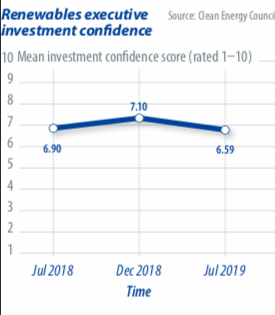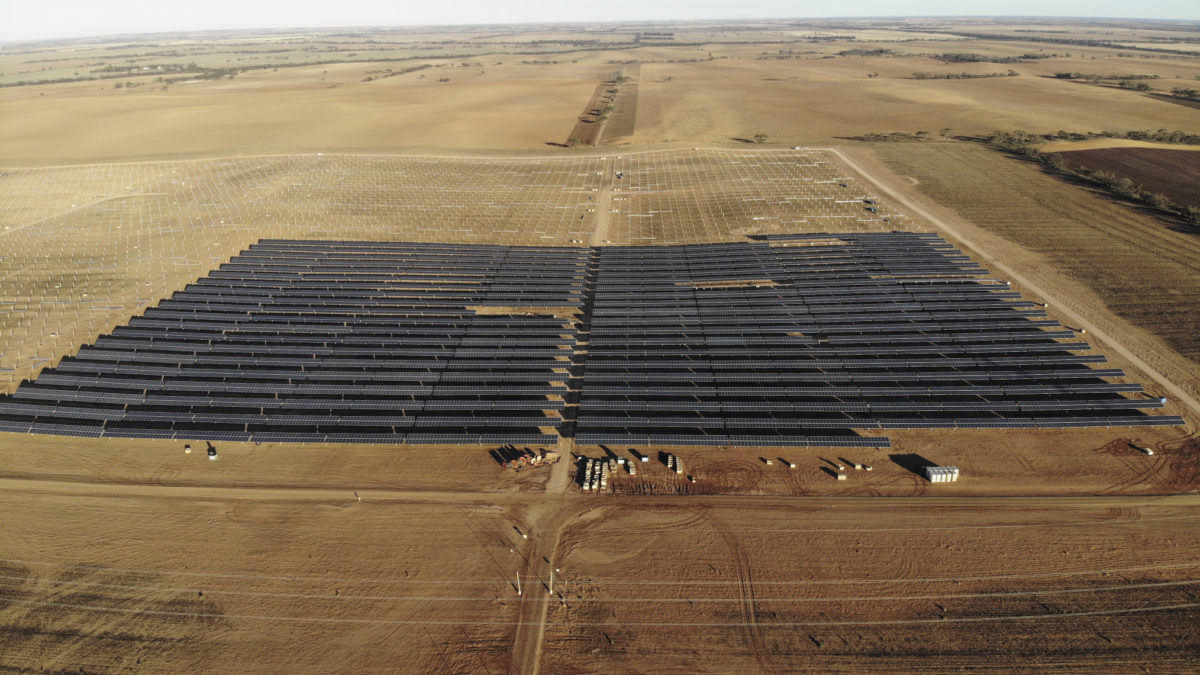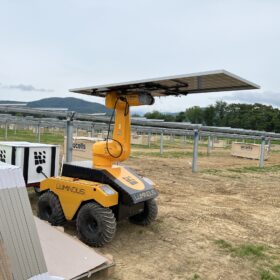From the September edition of pv magazine
Australia’s large-scale solar boom faces serious constraints in the form of a long and skinny electricity network – making some ideal sites unattractive to project developers. Legacy regulations and a lack of transparency have also caused last-minute roadblocks and costly delays for developers.
How did transmission capacity and connection to the electrical grid become the biggest obstacles to Australia’s supercharged push toward a renewable-energy future? With Rystad Energy estimating that 70 GW of large-scale renewables are in the pipeline, falling solar costs bumping aging coal generators off the map, and financiers jumping on board, it all seemed to be going so well.
 “I’d observe that as an industry we’ve delivered on the 2020 Renewable Energy Target. Delivering on this is causing technical challenges,” said John Titchen, managing director of Goldwind, at the Australian Clean Energy Summit 2019 in July. “Why, as a country, have we put a target in for people to run at, without preparing the runway?”
“I’d observe that as an industry we’ve delivered on the 2020 Renewable Energy Target. Delivering on this is causing technical challenges,” said John Titchen, managing director of Goldwind, at the Australian Clean Energy Summit 2019 in July. “Why, as a country, have we put a target in for people to run at, without preparing the runway?”
Australian renewable-energy developers and investors have experienced a world of pain over the past 18 months to two years, following a spike in projects being slowed through approvals and connections by long-known but poorly understood grid regulations. Unknown congestion at seemingly ideal project sites, as well as last-minute requirements to shore up system strength with the addition of synchronous condensers, have added to their woes, while transmission constraints have resulted in earnings-shrinking marginal loss factors (MLFs), and curtailment regimes have been enforced to keep the grid stable.
Tough times
“Don’t underestimate the impact of system strength on your financial models,” said Kate Osaze, grid-connections manager for ESCO Pacific, at the CEC Large Scale Solar Forum in May of this year. ESCO had been in extensive consultations with the Australian Energy Market Operator (AEMO) and network service providers throughout the development of its 175 MW Finley Solar Farm in New South Wales. But a few days before the connection was scheduled, the developer was notified by the network service providers that the project would require a synchronous condenser – a costly piece of equipment.
“As you would expect, you’re going through negotiations with your OEM, you’ve negotiated with your EPC contractors, you have a PPA [power purchase agreement] in place – all these contractual obligations are in parallel,” said Osaze.
To be notified abruptly towards the tail end of the connection process that you need to spend millions of extra dollars on a project is a huge ask for any business to absorb. 
“We were able to navigate this with the help of a very strong in-house team,” said Osaze. She recommends factoring in delays due to the huge number of applications received by network service providers, and their likely inexperience with constant adjustments in rules and processes, such as the relatively new requirement for PSCAD modelling of each project.
Old dog, no new tricks
Earlier this year, analysis by Rystad forecast that the decades-old MLF mechanism imposed on solar PV developments would diminish the revenues of at least six proposed large-scale solar farms in 2019-20 by 10% or more. This blow to project economics represents the calculated loss of electrons, as solar-farm output flows from power plant to transmission node and on to the ultimate consumer load.
“If the MLF issue is not addressed in the short to medium term,” asks Simon Corbell, chief adviser at Energy Estate, “will we see investors just too shy to invest because of the real unpredictability of the MLF regime and the compounding effect of it?”
The Clean Energy Council’s most recent biannual Clean Energy Outlook – Confidence Index appeared to reflect this sentiment. The latest index saw energy industry leaders’ average confidence levels falling on a scale of one to 10, from 6.9 points in July 2018 and 7.1 points in December 2018, to a one-year low of 6.59 in mid-2019.
Some stakeholders believe MLFs provide an appropriate signal as to which sites on the existing grid are less suited to substantial solar farm development than others. Simon Taylor, manager of network customers at Queensland’s high-voltage transmission network operator Powerlink, describes an MLF as a “locational signal. It’s like, ‘Is there sun? OK, that’s a good place to connect. Is there transmission? Is there a good loss factor?’ These are all locational signals. They all work well.”
Open access
One of the greatest conundrums facing connection applicants and network service providers under potentially outdated “open access” regulations are confidentiality rules which prevent them from communicating to a would-be generator about the number of other parties, and project capacities, that are trying to connect at any point on the grid. A draft rule change was published by the Australian Energy Market Commission (AEMC) on Aug. 1 that aims to improve the transparency of applications. This would give developers a crucial heads-up about likely development congestion at certain grid connection points and the possibility of curtailment at various otherwise “ideal” locations.
Powerlink’s Taylor reports that the network operator was processing 40 applications for connection at the time of writing. “Open access doesn’t mean there’s access at every point on the network, and it’s open to everyone at every moment,” he says. The proposed rule change will enable more open-generator discussions about where each generator might best be placed relative to other parties, relative to the network, and how it will change.
AEMO published its inaugural Integrated System Plan (ISP) in July 2018. Its aim is to provide a path to development for transmission that will eventually connect up to 37 identified Renewable Energy Zones (REZs) with consumers, with pumped-hydro storage projects and for load-sharing across the National Energy Market (NEM). But the consultation process can be painstaking, and the renewables industry is united in its call for an accelerated approach.

In April 2019, the AEMC introduced a rule change to streamline regulatory processes for three priority projects identified in the ISP: upgrades for the interconnection between Queensland and New South Wales (known as QNI), between Victoria and New South Wales (VNI), and for the construction of a new 800 MW interconnector between Robertstown, South Australia, and Wagga Wagga in New South Wales (Project EnergyConnect), which links on the way via Buronga, to Red Cliff in the Victorian network.
Each project will increase capacity for the bidirectional flow of energy across state lines, with Project EnergyConnect, a joint development of TNSPs ElectraNet and TransGrid, opening up a new 900-kilometer corridor for renewable generators to strategically connect to high-capacity transmission.
Even with acceleration by AEMC and the cooperation of the New South Wales and South Australian state governments in allowing development-approval processes to run in parallel with the three-stage economic cost-benefit analysis known as the Regulatory Investment Test for Transmission (RIT-T), the project will have been in development for around seven years by the time it is built in 2022-23.
In western Victoria, clusters of renewables development have occurred around towns such as Horsham and Terang, with some 2 GW of wind and solar generation built or scheduled for commissioning by 2020. AEMO expects a further 3 GW of new generation to be constructed in the region by 2025, plus another 1 GW, all in line with Victoria’s renewable energy target of 50% by 2030.
However, the region has become notorious for its grid limitations, which have resulted in widespread revenue-diminishing output downgrades from utility-scale solar farms through MLFs. Other developments, of which Finley Solar Farm was one, have been given the choice of adding grid-firming kit such as synchronous condensers, or just waiting for network upgrades.
In July, AEMO published an assessment of strategic investments in western Victoria’s transmission network that would enable up to 6 GW of wind and solar farms in the coming decade. The AUD 370 million ($249.9 million) investment is calculated to produce a total return of AUD 670 million in market benefits – or a net return of AUD 300 million. But the proposal, if it comes to fruition, will be delivered over six years to 2025.
That’s a long time for investors to wait for increased certainty, and this summary of procedures doesn’t begin to touch on the marketplace regulations that must be adapted to fairly allocate the costs of developing and upgrading transmission among the beneficiaries: generators and consumers.
Australia’s energy market, as well as its transmission, regulation and generation systems, are in a state of continuous change, and the wheels of consultation grind slowly. Too slowly, according to Clean Energy Council CEO Kane Thornton, who says that ironically the rate of change is both too much and not enough.
“Too much change spooks investors, makes it even harder to forecast the future wholesale energy price or adds unnecessary regulatory burden and cost on project development,” says Thornton. “At the same time there isn’t enough change that brings the regulatory and market environment into the 21st century.”
On the flip side, the transmission bottlenecks and grid expansion plans are providing opportunities for large-scale energy storage installations – perhaps most vividly demonstrated by the success of SA’s Hornsdale Battery Reserve, installed in 2017. These opportunities, and the challenges, will be explored in the second part of this article to be published next month.
This content is protected by copyright and may not be reused. If you want to cooperate with us and would like to reuse some of our content, please contact: editors@pv-magazine.com.









1 comment
By submitting this form you agree to pv magazine using your data for the purposes of publishing your comment.
Your personal data will only be disclosed or otherwise transmitted to third parties for the purposes of spam filtering or if this is necessary for technical maintenance of the website. Any other transfer to third parties will not take place unless this is justified on the basis of applicable data protection regulations or if pv magazine is legally obliged to do so.
You may revoke this consent at any time with effect for the future, in which case your personal data will be deleted immediately. Otherwise, your data will be deleted if pv magazine has processed your request or the purpose of data storage is fulfilled.
Further information on data privacy can be found in our Data Protection Policy.